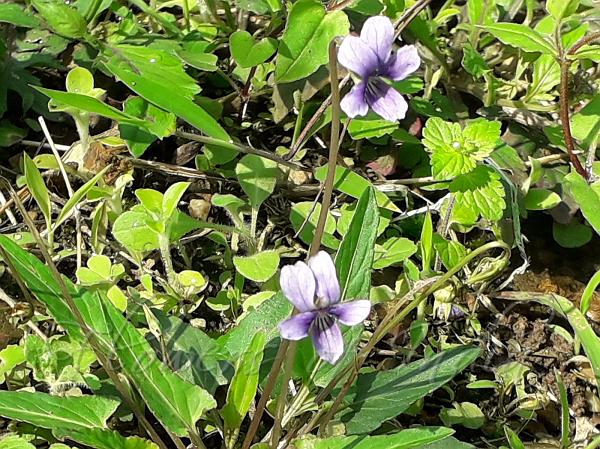|
| Chinese Violet |
|

|

| File size | 507327 |
| Original date | 1/2/17 6:49 AM |
| Resolution | 1400 x 1050 |
| Flash | Flash did not fire |
| Focal length | 3.6mm |
| Exposure time | 1/768s |
| Aperture | 1.9 |
| Focus Distance | |
| Metering Mode | Center weighted average |
| Camera make | samsung |
| Camera model | SM-J400F |
| Sensor type |
|
|
|
|
Photo: |
Botanical name: Viola philippica Family: Violaceae (Violet family)
Synonyms: Viola patrinii var. chinensis, Viola alisoviana
Synonyms: Viola patrinii var. chinensis, Viola alisoviana
Chinese Violet is a perennial, virtually stemless
herb, 4-14 cm tall, up to 20 cm tall at fruiting. Flowers are
purple-violet or purplish, rarely white, light colored and
purple-striped at throat, medium-sized. Flower-stalks usually numerous,
equaling or exceeding leaves, slender, hairless or finely velvet-hairy,
with 2 linear bracteoles near middle. Sepals are ovate to
ovate-lanceshaped, 3-7 x 0.7-1.8 mm, tip tapering; appendages short,
1-1.5 mm, 1/2 to 1/6 as long as sepal, tip rounded or finely toothed.
Petals are obovate or oblong-obovate, lateral ones 1-1.2 cm, inside
hairless or rarely lightly bearded, anterior one 1.3-2 cm (spur
included), inside purple-veined. Spur is tubular, 3-8 mm, 2-5 x as long
as calycine appendages. Leaves are numerous, basal; leaf-stalk usually
1-2 x exceeding blades at anthesis, very narrowly winged in upper part,
up to 10 cm at fruiting, finely velvet-hairy or hairless. Upper blades
are oblong-lanceshaped or triangular-ovate, usually smaller than lower
ones; lower ones oblong, narrowly ovate-lanceshaped, or oblong-ovate,
1.5-4 x 0.5-1 cm, base flat or wedge-shaped, rarely slightly
heart-shaped, margin shallowly rounded toothed, tip blunt. Capsules are
ellipsoid, 5-12 mm, hairless. Chinese Violet is found in fields,
grassy places on mountain slopes, forest margins, thickets, roadsides,
below 1700 m, in NE India, China and SE Asia. Flowering: February-May.
Medicinal uses: Chinese Violet is a widely
used herb in Chinese traditional medicine. It is an important
constituent of the traditional Chinese medicine Zi Hua Di Ding, a
drug with many documented local uses. One example is its use in
treating beriberi.
Chinese Violet is a widely
used herb in Chinese traditional medicine. It is an important
constituent of the traditional Chinese medicine Zi Hua Di Ding, a
drug with many documented local uses. One example is its use in
treating beriberi.
Medicinal uses:
 Chinese Violet is a widely
used herb in Chinese traditional medicine. It is an important
constituent of the traditional Chinese medicine Zi Hua Di Ding, a
drug with many documented local uses. One example is its use in
treating beriberi.
Chinese Violet is a widely
used herb in Chinese traditional medicine. It is an important
constituent of the traditional Chinese medicine Zi Hua Di Ding, a
drug with many documented local uses. One example is its use in
treating beriberi. | Identification credit: Tabish | Photographed in Pasighat, Arunachal Pradesh. |
• Is this flower misidentified? If yes,